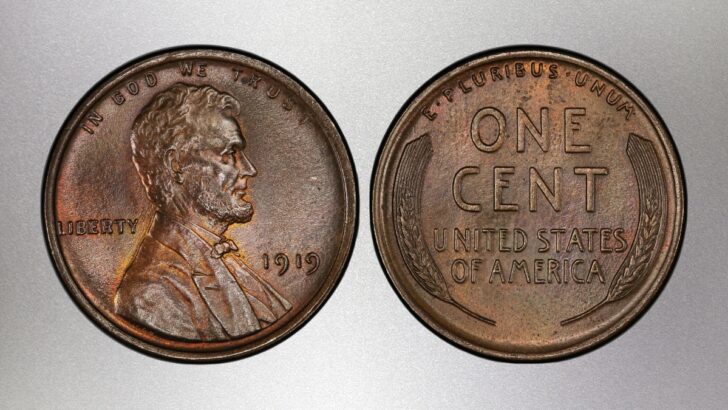During World War I, the U.S. Mint struck enormous numbers of coins to meet the demands of commerce and a wartime economic boom the nation enjoyed. However, not many of those coins were preserved with the high degree of care needed to keep them as high-grade uncirculated specimens a century later. The 1919 Lincoln wheat penny thus presents a paradox for collectors. Lower grade coins remain cheap and easily available. Higher grade uncirculated coins are quite expensive, and collectors may have to look to find ideal choices.
Production of the 1919 Wheat Penny
The year 1919 started with a temporary shortage of pennies. In part, this arose with the passage of a wartime luxury tax, which bolstered the need for small coins in commerce. In addition, the economy continued strong, even though World War I ended in November 1918. Production reached record levels, continuing the trend set during the war. All three branches of the U.S. Mint, in Philadelphia, Denver and San Francisco, coined wheat pennies during 1919.
| Date | Philadelphia | Denver | San Francisco |
| 1919 | 392,021,000 | 57,154,000 | 139,760,000 |
How Much Are 1919 Wheat Pennies Worth?
| 1919 Penny Value Chart | ||||||
| Date | Grade | |||||
| Good G4 | Extra Fine XF40 | About Uncirculated AU55 | Uncirculated MS64 | Uncirculated MS65 | Uncirculated MS66 | |
| 1919 1C BN | $0.36 | $1.50 | $6.08 | $27.00 | $88.00 | — |
| 1919 1C RB | — | — | — | $54.00 | $108.00 | $195.00 |
| 1919 1C RD | — | — | — | $94.00 | $286.00 | $488.00 |
| 1919-D 1C BN | $0.75 | $10.80 | $40.50 | $169.00 | $325.00 | — |
| 1919-D 1C RB | — | — | — | $280.00 | $992.00 | $1,090.00 |
| 1919-D 1C RD | — | — | — | $390.00 | $1,220.00 | $4,620.00 |
| 1919-S 1C BN | $0.40 | $6.08 | $30.92 | $195.00 | $416.00 | — |
| 1919-S 1C RB | — | — | — | $332.00 | $878.00 | $2,000.00 |
| 1919-S 1C RD | — | — | — | $780.00 | $5,620.00 | $24,000.00 |
While circulated 1919 pennies can routinely be purchased for under $10, 1919 pennies from the Denver or San Francisco Mints are inexpensive only at the lowest grades. The better grades of circulated 1919-D and 1919-S pennies easily cost tens of dollars.
Similarly, uncirculated 1919 pennies struck in Philadelphia can often be found for a hundred dollars or less, while the very best uncirculated 1919-D or 1919-S wheat pennies can easily run into the tens of thousands of dollars.
Values for 1919 Pennies
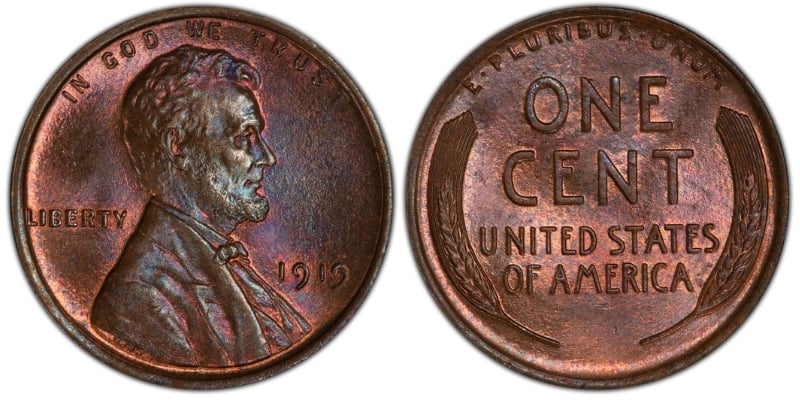
In 1919, the Philadelphia mint set a record for penny mintage, by striking almost 400,000,000 coins. This quantity would not be equaled until 1940. The 1919 wheat penny is thus common in both circulated and uncirculated grades. Uncirculated coins are easily found through the mid-range grades like MS-65. Few specimens have serious problems with spots, and gems are also plentiful.
In 1916, the Mint reworked the hubs, or master dies, for the wheat penny. While some of the sharper details had begun to wear and fade, the dies produced remained of high quality. The mint also went to some pains over production, with carefully made and treated coin planchets being put to use in the coining process, and careful calibration of the coin presses.
The resulting wheat pennies are generally well-struck, and sharp. Many full-detail wheat pennies survive, and are available for collectors.
At the lower circulated grades, Good and Fine, a 1919 wheat penny should be readily available for under $0.50. Nicer circulated coins, graded Extremely-Fine or About-Uncirculated, should run between $1.50 and $6.00. Given the age of the 1919 penny, it should not be surprising that oxidation takes a certain toll on many uncirculated specimens, which retain their grade even as they lose some of their luster. An uncirculated 1919 penny, graded MS-63 BN should sell for $18.90, while a slightly nicer one, graded MS-65 should sell for $88.
Uncirculated 1919 red-brown pennies, which retain some of their original luster cost somewhat more, but remain affordable. An uncirculated 1919 penny, graded MS-63 RB should sell for about $27, while a better specimen, graded MS-65 RB should cost about $108; The very best uncirculated specimens, retaining their original red color, are the most expensive. A 1919 wheat penny, graded MS-63 RD should cost just under $50. A better specimen, graded MS-65 RD, should cost just under $300. A penny graded MS-67 RD should cost about $1,500, or perhaps somewhat less. As recently as October 2019, a 1919 Lincoln penny, graded MS-67+ RD sold for $1,200 at Heritage Auctions.
Turning to more recent sales. in August 2022, a 1919 penny, graded MS-68 RD sold for $12,000 at auction. A similar coin sold in May 2023 at Heritage Auctions for $16,800. The auction sales description pointed out that only 19 examples of 1919 pennies graded MS-68 RD were known to exist, and only one coin was known to grade higher.
Values for 1919-D Pennies
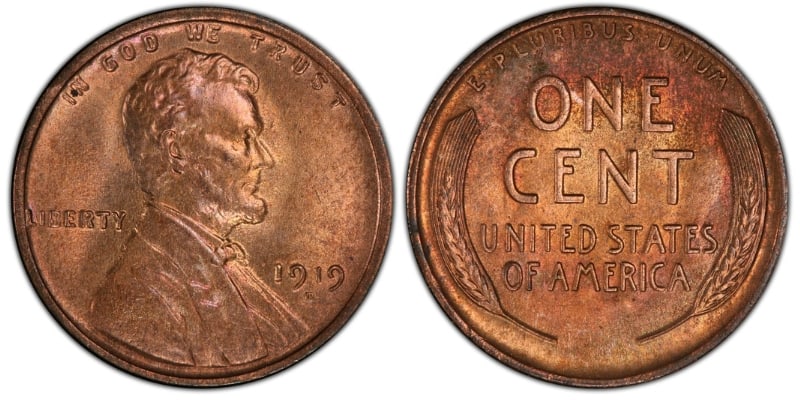
The Denver Mint also set a record for penny mintage in 1919, which it would not reach again until 1940. Circulated specimens and lower grade uncirculated specimens are thus readily available.
Unlike the Philadelphia Mint, the Denver Mint tended to use coin dies past the point they were worn out. Reverse dies were especially prone to deterioration and overuse. Wheat ears sometimes begin to blend into the background rim of the coin.
High grade uncirculated coins which have both their original color and a sharp strike might be harder for a collector to find. Uncleaned specimens with the original color often have spots or other damage. In the case of penny reverses, wavy patterns are also found fairly often. The center of the obverse can also sometimes be weakly struck.
The lower circulated grades, of Good and Fine, are more expensive than the same specimens from either Philadelphia or San Francisco, but not vastly more so. A 1919-D wheat penny in those grades should cost between $0.75 and $1.95. Prices for nicer examples of circulated coins, graded Extremely-Fine or About-Uncirculated should run between $10 and $40 for 1919-D wheat pennies. Brown uncirculated 1919-D wheat pennies can be quite expensive. A 1919-D wheat penny graded MS-63 BN should cost about $115, while a 1919-D wheat penny graded MS-65 BN may cost as much as $325.
Red-brown or red uncirculated specimens of 1919-D wheat pennies are also quite expensive, compared to the rest of the year’s penny mintage. A 1919-D wheat penny graded MS-63 RB will cost about $160, while a 1919-D penny graded MS-65 RD will run almost $1000. The prices for red examples of 1919-D pennies in those grades are $240 and $1220 respectively. At the very top of the line, a 1919-D penny graded MS-67 RD may cost over $36,000. Certainly, in 2019, a 1919-D penny graded MS-67 RD sold for $31,000. In 2020, a 1919-D penny graded MS-66+ RD sold for $13,800. In 2016, a 1919-D penny graded MS-65 RD sold for $14,100.
Values for 1919-S Pennies
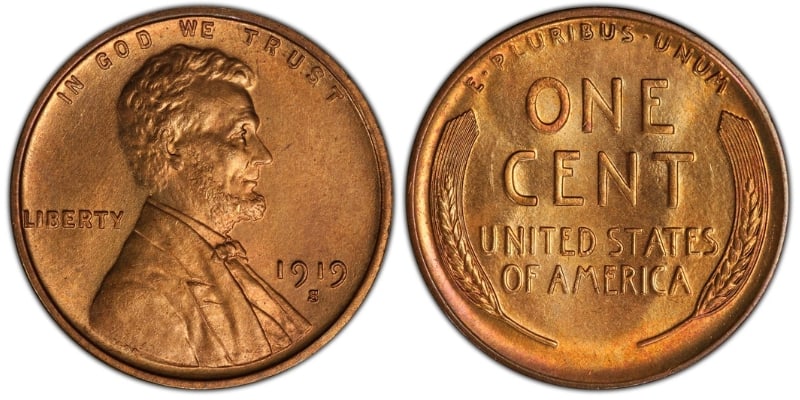
Production of wheat pennies at the San Francisco Mint in the year 1919 was four times what it had been in 1918. It is easy for collectors to find circulated and lower-grade uncirculated specimens of any grade. As with the Denver Mint, the dies at San Francisco were often overused, and badly worn before finally being retired. Well-struck, sharp examples with the original color are rare, and may challenge collectors. Well-struck uncirculated coins with full detail are also hard to come by. Many uncirculated coins which retain their original color often have unusual hues because of aging.
At the lower ranges of circulated grades, Good and Fine, 1919-S wheat pennies are slightly more expensive than those from Philadelphia, but not vastly more expensive. A 1919-S penny graded good should cost about $0.40. A specimen graded fine should cost about $1.10. Better grades of circulated coin will cost slightly more than those struck in Philadelphia, and somewhat less than those struck in Denver. A 1919-S wheat penny graded as XF-40 should cost about $6, which is about the same amount we would expect to pay for a 1919 wheat penny graded at AU-55. A 1919-S penny graded AU-66 should cost a bit over $30, which is more than the 1919 penny of the same grade, but less than the $40 we might expect to pay for a 1919-D penny of the same grade.
Uncirculated brown coins fall into the same pattern, at least at the lower grades. A 1919-S penny graded MS-63 BN should cost $122. Only at the higher grade does the 1919-S wheat penny become scarce. A 1919-S penny graded MS-65 BN should cost over $400.
Red-Brown and Red examples of 1919-S pennies can be somewhat expensive. A 1919-S penny, graded MS-63 RD, should cost about $160. A 1919-S penny graded MS-65 RD should sell for about $180. Very nice red 1919-S pennies can command significant sums. A 1919-S penny graded MS-63 RD should sell for slightly over $400. A similar penny, graded at MS-65 RD, can sell for thousands of dollars. At the top of the scale, 1919-S pennies graded above MS-66 simply don’t seem to exist, thus raising the price for those coins graded MS-66.
In January 2019, a 1919-S wheat penny, graded MS-66, sold for $20,400 at Heritage Auctions. The catalog noted that only three such 1919-S pennies of that grade were known to exist and that the last time the auction house handled a similar coin was in 2001. That particular coin sold nearly 20 years earlier for $19,550, in April 2001. A 1919-S penny, graded MS-65 RD sold for $11,100 in August 2022.
Were any 1919 Proof Wheat Pennies Produced?
The U.S. Mint stopped minting proof coins in 1916, citing a lack of interest among the general public and coin collectors. Proof coinage remained on hold until 1936, then was quickly discontinued after the U.S. entered World War II. There are no genuine 1919 proof wheat pennies.
How Much Are 1919 Wheat Penny Errors Worth?
Many collectors specialize in mis-struck or “error” coins. Although the Mint takes some pains over the coining process to make certain that pieces emerging from the coin press are struck carefully and conform to the requisite standards, accidents occur. Even a tiny percentage in a mintage of over 400 million pennies can add up to a significant number of mis-shaped coins. These coins can have significant value over and above that of ordinary coins of the same or even higher grades.
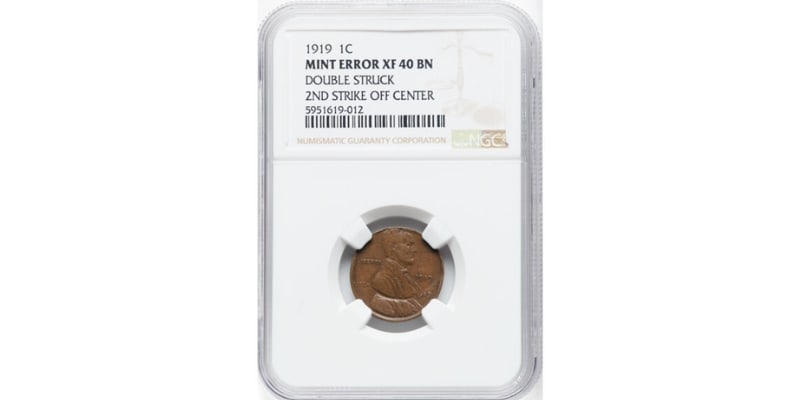
In June 2023, Heritage Auctions offered a 1919 penny, with not one but two errors. The coin was triple struck, meaning that it failed to fall off of the coin press not once, but twice, so that the coin dies came down upon it repeatedly. On the third strike, the coin also spun slightly in the die, leaving it off center. This very unusual specimen, graded at XF-40, sold for $468. An ordinary coin of this variety would have sold for about $1.50.
Also in June 2023, at the same auction, Heritage offered a more mundane error. A 1919 wheat penny, graded XF-45, and struck 10% off center, sold for $83. A more drastic off-center strike, of a 1919-S wheat penny, graded XF-45, struck 35% off center, sold for $119. This particular coin had a lamination, or weakness to the planchet causing part of it to flake when it was coined.
In December 2022, a 1919-S Lincoln penny, struck 35% off center, and graded MS-65 BN, sold for $432 at auction. Given the high price of the underlying ordinary coin, which also sells for over $400, this particular coin received little extra premium from the error.
In September 2019, a 1919-D wheat penny, graded MS-64 BN, struck 40% off center, with the date and mintmark present but with the phrase “In God We Trust” missing, sold for $660 at Heritage Auctions. On the reverse, one of the wheat heads was largely missing as well. An ordinary coin of this variety would sell for about $200, so the sale realized a substantial premium over the ordinary cost.
Technical Specifications of the 1919 Wheat Penny
The Lincoln wheat penny first appeared in 1909 as part of a general redesign of American coinage undertaken by Theodore Roosevelt. The designer of the coin, Victor D. Brenner, was a sculptor and medallion engraver who came to Roosevelt’s attention when he sculpted a bust of the President. The design of the penny was novel, in that it featured a portrait of an actual individual, rather than an allegorical figure; while this had been undertaken on commemorative coins, it had not been tried before on actual circulating coins. The design proved immediately popular with the general public and continued, in one form or another, for the following century before being temporarily superseded by a design which commemorated the bicentennial of Lincoln’s birth. The obverse sculpted by Brenner remains in use today, making it the longest running coin design used in American history.
The 1919 wheat penny weighs 3.11 grams and has a diameter of 19 millimeters. It is not a copper coin, contrary to popular belief, but a bronze coin made of 95% copper and 5% tin and zinc.
Summary
A beginning collector wanting to find three wheat pennies from 1919, one from each mint, to place in a penny folder will have no difficulty finding specimens. Some of the higher graded circulated specimens may be a bit pricey for such an exercise, and a beginning ocllector may have to settle for somewhat less than perfect coins to place in that folder.
More advanced collectors will also experience a challenge. While uncirculated 1919 wheat pennies are available from all three mints, the quality may be somewhat lower than usual, and collectors who set high standards may find themselves waiting a while before they are able to find just the right coin. Still, subject to those parameters, the 1919 wheat penny is an available, accessible coin for just about every price range.
